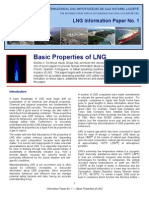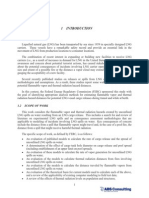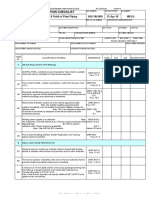Emergency Responder Guidance LNG Brochure 20190731
Emergency Responder Guidance LNG Brochure 20190731
Uploaded by
Ahmed ElbarbaryCopyright:
Available Formats
Emergency Responder Guidance LNG Brochure 20190731
Emergency Responder Guidance LNG Brochure 20190731
Uploaded by
Ahmed ElbarbaryOriginal Title
Copyright
Available Formats
Share this document
Did you find this document useful?
Is this content inappropriate?
Copyright:
Available Formats
Emergency Responder Guidance LNG Brochure 20190731
Emergency Responder Guidance LNG Brochure 20190731
Uploaded by
Ahmed ElbarbaryCopyright:
Available Formats
Purpose More Information
• Understand the properties and behavior of For more information on emergency response
liquefied natural gas (LNG) guidance:
• Identify LNG fuel tenders, locomotives, tank
cars, and intermodal portable tank cars BP Process Safety Series: LNG Fire Protection
Emergency
•
& Emergency Response, Institution of
• Understand potential chemical, cryogenic, and
Chemical Engineers, 2007
flammability hazards
• Emergency Response Guidebook, U.S.
Responder
• Execute the basics of LNG emergency response
Properties and behavior of LNG
Department of Transportation, 2012
Guidance
upon release
• LNG is a cryogenic liquid formed from natural
gas (NG) cooled to a very low temperature of
–260 °F (-162 °C) at atmospheric pressure.
• When heat is added to LNG at atmospheric
pressure, it boils and is converted into NG.
• LNG is colorless, odorless, and non-toxic.
• The volume ratio of LNG at –260 °F to
atmospheric pressure NG at 70 °F is 1:600.
• LNG or vapor leakage is detected using only
certified instrumentation, such as hydrocarbon
concentration sensors.
• LNG is stored in insulated, thermos-like double
-walled tanks. Liquefied Natural
• LNG leaks and spills lead to the formation of a
cold, ground-hugging, white, visible natural
Gas (LNG)
gas cloud, which is visible due to water vapor
from the atmosphere condensing into the
cloud as a fog.
Identification of LNG • Flammability hazards Basics of LNG emergency response
tenders and tank cars – The natural gas cloud formed by LNG • Stay upwind. Keep unauthorized personnel
• A fuel tender will always be coupled to a vaporization and mixed with air will ignite away.
locomotive. It may have decals indicating only when the gas-air mixtures is in
• Do not enter an LNG cloud.
that the tank content is “Liquefied Natural concentrations between 5% – 15% by
Gas.” volume. • Look for recognizable signs of escaping gas
– If a vapor cloud ignites, a flash fire will form
(sound and/or white cloud). Escaping gas is
• An LNG tank car or intermodal portable tank odorless.
will have a placard with “UN 1972” and will and propagate (upwind) to the source of
be marked ‘”Refrigerated Methane Liquid.” vapor. Occasionally, for short distances • Eliminate ignition sources (no smoking,
downwind of ignition point, the cloud may flares, sparks, or flames in the immediate
Potential hazards — respiratory, propagate a flash fire. area).
cryogenic, and flammability – Natural gas flames burn cleaner and more • Use thermal protective clothing and gloves in
• Chemical hazards luminously that gasoline flames of the addition to respiratory protection.
same size.
– The rapid evaporation of released LNG into • Initiate emergency shutdown functions.
vapor can displace air and can cause – LNG vapor mixed with air in the
asphyxiating conditions in confined spaces. flammability range is not explosive in • Stop the release if possible and safe to do so.
unconfined conditions.
– If only a small amount of LNG is released, it • Do not direct water at spill or source of leak.
will evaporate and the vapors generated • Verify whether cab sensor/detector has been
will quickly dissipate in the atmosphere. activated in the locomotive if unsure about
• Cryogenic hazards whether there is a leak.
– Contact with cryogenic liquid, cold surfaces, 4 Contact Us
or cold vapor can cause burns, also known
as cold burns.
3 0 Dr. Phani Raj
– Breathing cold vapors can damage lung General Engineer
tissue. Hazardous Material Division
– LNG contact with materials, such as carbon (202) 493-6306
steel, can lead to material embrittlement. Phani.Raj@dot.gov
You might also like
- Project Report On Flexible Packaging (Rotogravure Printing)Document7 pagesProject Report On Flexible Packaging (Rotogravure Printing)EIRI Board of Consultants and Publishers50% (2)
- BFP Fire Safety SeminarDocument60 pagesBFP Fire Safety SeminarJulius Cesar Cudera100% (2)
- Product Knowledge (New Edited)Document54 pagesProduct Knowledge (New Edited)lestermusca100% (2)
- Rate AnalysisDocument8 pagesRate Analysissenthil50% (2)
- Physical Properties:: Haldia RefineryDocument43 pagesPhysical Properties:: Haldia Refinerymujeebtalib100% (3)
- Davies 5-700 Liquid Tile PrimerDocument1 pageDavies 5-700 Liquid Tile PrimerBert Eng0% (1)
- LNG INFORMATION For Firefighters 1-1Document2 pagesLNG INFORMATION For Firefighters 1-1Ahmed ElbarbaryNo ratings yet
- LNG Safety Document Final PDFDocument10 pagesLNG Safety Document Final PDFAnonymous 6Ozj8Jmp1ZNo ratings yet
- Oil and Gas Safety 2013Document23 pagesOil and Gas Safety 2013JohNo ratings yet
- Gas Detection at LNG Facilities ETA - MARDocument7 pagesGas Detection at LNG Facilities ETA - MARSaBilScondNo ratings yet
- GIGNLDocument49 pagesGIGNLHanumanthNo ratings yet
- International Journal of Safety and Security Engineering: Received: 10 January 2021 Accepted: 16 July 2021Document10 pagesInternational Journal of Safety and Security Engineering: Received: 10 January 2021 Accepted: 16 July 20215.s.5.c1633No ratings yet
- Handling of cryogenic liquefied gases_tcm171-72930Document3 pagesHandling of cryogenic liquefied gases_tcm171-72930Jorn VanheesNo ratings yet
- What - Is - LNGDocument19 pagesWhat - Is - LNGAhmed ZNo ratings yet
- Methane MSDSDocument2 pagesMethane MSDSa0% (1)
- BFP Basic InformationsDocument53 pagesBFP Basic InformationsKate CzareneNo ratings yet
- Attachment 1. LNG Safety: Table 1.1 Comparison of Properties of Liquid FuelsDocument6 pagesAttachment 1. LNG Safety: Table 1.1 Comparison of Properties of Liquid FuelsLund2016No ratings yet
- Potential Fire Scenarios and Emergencies at LPG FacilitiesDocument14 pagesPotential Fire Scenarios and Emergencies at LPG FacilitiesEngrAmadou MamoudouNo ratings yet
- LNGBunkering - UK - Club - FinalDocument12 pagesLNGBunkering - UK - Club - FinalMr-SmithNo ratings yet
- (PDF) LNG - Fundamental Principles - CompressDocument64 pages(PDF) LNG - Fundamental Principles - Compressjhon berez223344No ratings yet
- Safety & Fire Fighting For LNGDocument7 pagesSafety & Fire Fighting For LNGmohb100% (2)
- Hydrogen Safety OverviewDocument2 pagesHydrogen Safety OverviewgnkameshNo ratings yet
- LPG Fire Characteristics Fire Control PDFDocument4 pagesLPG Fire Characteristics Fire Control PDFAnandababuNo ratings yet
- NaturalGasandSafetyPresentation TheLacledeGroupDocument14 pagesNaturalGasandSafetyPresentation TheLacledeGroupengrashok2190No ratings yet
- Main Type of LNG HazardDocument3 pagesMain Type of LNG HazardWildan IrfansyahNo ratings yet
- LNG Physical PropertiesDocument6 pagesLNG Physical PropertiesSivapriya SamyNo ratings yet
- Study On The Operating Principles of Liquefied GasesDocument11 pagesStudy On The Operating Principles of Liquefied GasesAndrei SrbNo ratings yet
- BFP Fire Safety SeminarDocument60 pagesBFP Fire Safety SeminarMark Louie GuintoNo ratings yet
- LNG PresentationDocument70 pagesLNG Presentationajaykumarprasad100% (2)
- Basic Properties of LNG PaperDocument8 pagesBasic Properties of LNG PaperDimas AnggaNo ratings yet
- Basic LPG Product Knowledge Induction CourseDocument34 pagesBasic LPG Product Knowledge Induction CourseMha RizNo ratings yet
- wyklad basicDocument64 pageswyklad basicHaylor MuskNo ratings yet
- Unit 1: LNG Introduction and ProductionDocument39 pagesUnit 1: LNG Introduction and ProductionDeepak Sharma100% (1)
- Hazards Associated With LNGDocument2 pagesHazards Associated With LNGKimNo ratings yet
- 3.Bfp BasicsDocument53 pages3.Bfp BasicsVimarie TahendungNo ratings yet
- LNG PDFDocument5 pagesLNG PDFhanloveNo ratings yet
- LNG Codes and process safetyDocument10 pagesLNG Codes and process safetyHafed AbdulhadiNo ratings yet
- UK LPG SOPDocument10 pagesUK LPG SOPHafed AbdulhadiNo ratings yet
- Ftops 2a - LPG-LNG Hazards and ControlDocument26 pagesFtops 2a - LPG-LNG Hazards and ControlmyscriblkNo ratings yet
- ConsequenciasDocument6 pagesConsequenciasdennisroldanNo ratings yet
- Safety Advice 04 Cryogenic Liquefied Gases - tcm17-410827Document3 pagesSafety Advice 04 Cryogenic Liquefied Gases - tcm17-410827rajeevNo ratings yet
- Storage and Handling Safety in LPG PlantsDocument8 pagesStorage and Handling Safety in LPG PlantsEngrAmadou MamoudouNo ratings yet
- Safety Technical Problems AssociateDocument10 pagesSafety Technical Problems Associate5.s.5.c1633No ratings yet
- 5 Mins - Gas Detection - enDocument1 page5 Mins - Gas Detection - en孔超No ratings yet
- week 8Document47 pagesweek 8an.tanthuNo ratings yet
- Fire SafetyDocument40 pagesFire SafetyJinky Mae PobrezaNo ratings yet
- Risk Assessment-Hazards For Deep Water Port LNG Receiving TerminalsDocument17 pagesRisk Assessment-Hazards For Deep Water Port LNG Receiving TerminalsmacrobcsNo ratings yet
- CNG LCNG HCNGDocument29 pagesCNG LCNG HCNGShrey SimediyaNo ratings yet
- 3 Bfp-BasicsDocument53 pages3 Bfp-BasicsElaeca AbenNo ratings yet
- H2 Safety Q and A Feedback Webinar2 FINAL ENDocument13 pagesH2 Safety Q and A Feedback Webinar2 FINAL ENCristian PopaNo ratings yet
- Basic LNG Training: Presented By: Saurabh Girdhar Head, Marine Division. Ganpat UniversityDocument85 pagesBasic LNG Training: Presented By: Saurabh Girdhar Head, Marine Division. Ganpat UniversityVu Duc NguyenNo ratings yet
- 6.4 Basic Shipboard FirefightingDocument18 pages6.4 Basic Shipboard FirefightingJoeNo ratings yet
- week 10Document55 pagesweek 10an.tanthuNo ratings yet
- 1 Explosive ClassificationDocument25 pages1 Explosive Classificationsuyashgupta1818No ratings yet
- Fire Fighting TrainingDocument54 pagesFire Fighting TrainingVivek MehtaNo ratings yet
- LNG Risk and Hazards-OkayDocument14 pagesLNG Risk and Hazards-OkayTerry A. WaldropNo ratings yet
- Pdf-Lng-Terminal-Fasilitas Facilities - CompressDocument25 pagesPdf-Lng-Terminal-Fasilitas Facilities - CompressAndriansyahNo ratings yet
- Fires On ShipsDocument4 pagesFires On ShipsSan ShipyardNo ratings yet
- LPG LNGDocument98 pagesLPG LNGMUHAMMAD ZIDAN AMIRULLAHNo ratings yet
- Cargo Handling in LNG CarriersDocument86 pagesCargo Handling in LNG Carriersfarshid_b100% (6)
- Natural Gas: Operations and Transport: A Handbook for Students of the Natural Gas IndustryFrom EverandNatural Gas: Operations and Transport: A Handbook for Students of the Natural Gas IndustryNo ratings yet
- Marvels of Scientific Invention An Interesting Account in Non-technical Language of the Invention of Guns, Torpedoes, Submarine Mines, Up-to-date Smelting, Freezing, Colour Photography, and many other recent Discoveries of ScienceFrom EverandMarvels of Scientific Invention An Interesting Account in Non-technical Language of the Invention of Guns, Torpedoes, Submarine Mines, Up-to-date Smelting, Freezing, Colour Photography, and many other recent Discoveries of ScienceNo ratings yet
- A System of Instruction in the Practical Use of the BlowpipeFrom EverandA System of Instruction in the Practical Use of the BlowpipeNo ratings yet
- 104Document1 page104Ahmed ElbarbaryNo ratings yet
- 1.-ISS-Bladder-TanksDocument9 pages1.-ISS-Bladder-TanksAhmed ElbarbaryNo ratings yet
- UF50157Document2 pagesUF50157Ahmed ElbarbaryNo ratings yet
- PHMSA 2018 0025 0621 - Attachment - 1Document3 pagesPHMSA 2018 0025 0621 - Attachment - 1Ahmed ElbarbaryNo ratings yet
- FORM - 2 - Appendix 2.A - Fire Protection Codes MatrixDocument9 pagesFORM - 2 - Appendix 2.A - Fire Protection Codes MatrixAhmed ElbarbaryNo ratings yet
- Foam Spray Nozzle Ul ListedDocument2 pagesFoam Spray Nozzle Ul ListedAhmed ElbarbaryNo ratings yet
- SteelDocument56 pagesSteelyoungonhunt100% (16)
- Super-Bond Universal Ceramic Primer 2Document2 pagesSuper-Bond Universal Ceramic Primer 2Ranu Ganendra UtomoNo ratings yet
- MS PlateDocument7 pagesMS PlateEktaNo ratings yet
- StudentDocument71 pagesStudentNicu IonNo ratings yet
- WeldingDocument193 pagesWeldingavutu_kunduruNo ratings yet
- Casting, Forming and Joining Processes - Materials, Manufacturing and Industrial Engineering - ME - GATE Syllabus, Paper Solution, Question AnswerDocument44 pagesCasting, Forming and Joining Processes - Materials, Manufacturing and Industrial Engineering - ME - GATE Syllabus, Paper Solution, Question Answerraja375205No ratings yet
- Saic W 2005Document1 pageSaic W 2005Abdelaziz MohamedNo ratings yet
- Rajasthan PHED BSR 2021Document214 pagesRajasthan PHED BSR 2021write2souravdNo ratings yet
- me8361-MT 1 LabmanualDocument37 pagesme8361-MT 1 LabmanualHOD ITNo ratings yet
- Ceilcote 748Document1 pageCeilcote 748bollidNo ratings yet
- TDS Brilliant S621-S110Document3 pagesTDS Brilliant S621-S110Hari Dhuri100% (1)
- Gear Solutions May 2011 Company Profile PDFDocument3 pagesGear Solutions May 2011 Company Profile PDFmarijaNo ratings yet
- Difference Between Orthogonal and Oblique CuttingDocument6 pagesDifference Between Orthogonal and Oblique CuttingshanthakumargcNo ratings yet
- MRP: INR 16,000/-: Professional Knife SharpnersDocument2 pagesMRP: INR 16,000/-: Professional Knife SharpnersEchmumbai adminNo ratings yet
- L7 ccb232Document33 pagesL7 ccb232Last BofeloNo ratings yet
- Ekasit - Nisarantaraporn 1995 PHD Thesis PDFDocument278 pagesEkasit - Nisarantaraporn 1995 PHD Thesis PDFСтанислав ПодольскийNo ratings yet
- NAAMM Metal Finishes-ManualDocument116 pagesNAAMM Metal Finishes-Manualapply19842371100% (1)
- Repair WeldDocument25 pagesRepair WeldArnel TañecaNo ratings yet
- Vae40 707 TDSDocument3 pagesVae40 707 TDSThái NguyễnNo ratings yet
- Stainless Steel Design ManualDocument14 pagesStainless Steel Design ManualmirekwaznyNo ratings yet
- Year Minimills 2010Document8 pagesYear Minimills 2010mishtinilNo ratings yet
- (Popular Woodworking) Robert W. Lang-Classic Arts and Crafts Furniture - 14 Timeless Designs-Popular Woodworking Books (2013)Document162 pages(Popular Woodworking) Robert W. Lang-Classic Arts and Crafts Furniture - 14 Timeless Designs-Popular Woodworking Books (2013)H SHABANA100% (9)
- Rebuilding Caster RollsDocument8 pagesRebuilding Caster RollsBernardo BardottNo ratings yet
- Chemical BlackeningDocument3 pagesChemical Blackeningdaniel_sasikumarNo ratings yet
- Fabric Catalogue High Resolution Volume 2Document19 pagesFabric Catalogue High Resolution Volume 2Jawad RazaNo ratings yet
- Lec_10_Lecture_Material jetting v.1Document43 pagesLec_10_Lecture_Material jetting v.1Yasir A. Al-ShataifNo ratings yet
- A Critical Review On Recent Research Methodologies in Additive ManufacturingDocument11 pagesA Critical Review On Recent Research Methodologies in Additive ManufacturingAshutosh ShiroleNo ratings yet































































































